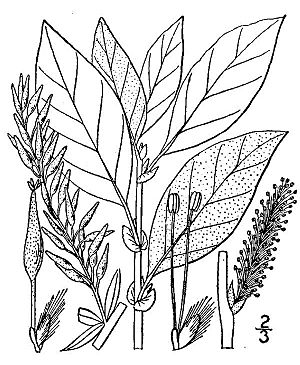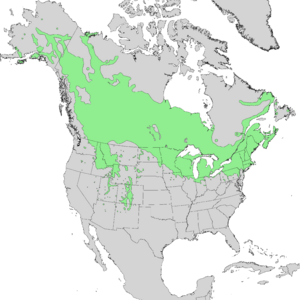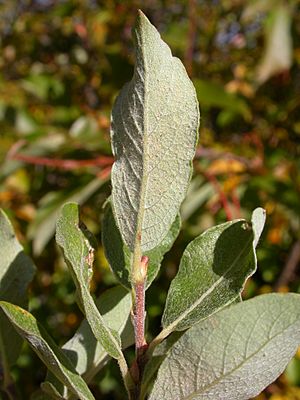Beaked willow facts for kids
Quick facts for kids Beaked willow |
|
|---|---|
 |
|
| Scientific classification | |
| Genus: |
Salix
|
| Species: |
bebbiana
|
 |
|
| Natural range of Salix bebbiana | |
| Synonyms | |
|
Salix perrostrata |
|
Salix bebbiana, also known as beaked willow or Bebb's willow, is a type of willow tree or shrub. It grows naturally across a large part of Canada and the northern United States. You can find it from Alaska and Yukon all the way south to California and Arizona. It also grows northeast to Newfoundland and New England. Some Native American groups call it red willow.
Contents
Where the Beaked Willow Grows
The beaked willow is usually a large, fast-growing shrub. It can also be a small, bushy tree. It often has many stems and can form thick groups of plants.
You will often find this willow in wet places. It likes loose, wet soils near rivers, lakes, swamps, and marshes. It can also grow in tough places like heavy clay or rocky soils. This makes it a very strong and adaptable plant. It is a common plant in many marshy areas where it grows.
What the Beaked Willow Looks Like
The leaves of the beaked willow grow one after another along the stem. They are simple and shaped like an oval. They are widest in the middle and get narrower towards the base and tip. The edges of the leaves are usually smooth, but sometimes they have tiny teeth.
When the leaves are grown, they are a dull blue-green color and feel smooth. New leaves are covered in soft, fine hairs. Each leaf can be up to 5 inches (13 cm) long and 1.5 inches (4 cm) wide.
How Beaked Willows Reproduce
Like other willows, this plant has separate male and female plants. This is called being dioecious. Both male and female plants grow small, hanging flower clusters called catkins.
Female flowers produce round seeds. These seeds are covered in long, thin fibers. These fibers help the seeds float on the wind. This allows them to spread to new places. The plant also spreads by growing new shoots from its base or from its roots. It can also spread by layering, where a branch touches the ground and grows roots. This helps the plant form groups of clones, which are exact copies of the parent plant.
Uses of the Beaked Willow
The beaked willow is very important for a special kind of wood called diamond willow. This wood has unique patterns and colors. It is often used for carving beautiful objects.
Native Americans have used the twigs and branches of this willow for a long time. They use them for basket weaving and making arrows.
This plant is also a host for many insects. Over 300 different kinds of butterflies and moths use the beaked willow as a place to live and eat.
Animals and the Beaked Willow
Many animals eat parts of the beaked willow. Domestic cattle especially like to eat its leaves. They find the leaves to be a tasty food source.
Beaked Willow Hybrids
The beaked willow can easily hybridize with other types of willow. This means it can mix its genes with other willow species. This creates new kinds of willow plants that share traits from both parents.
See also
 In Spanish: Salix bebbiana para niños
In Spanish: Salix bebbiana para niños


